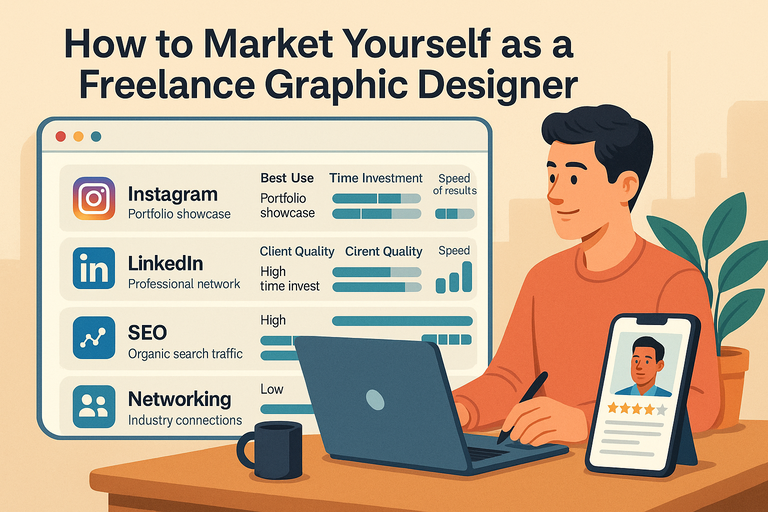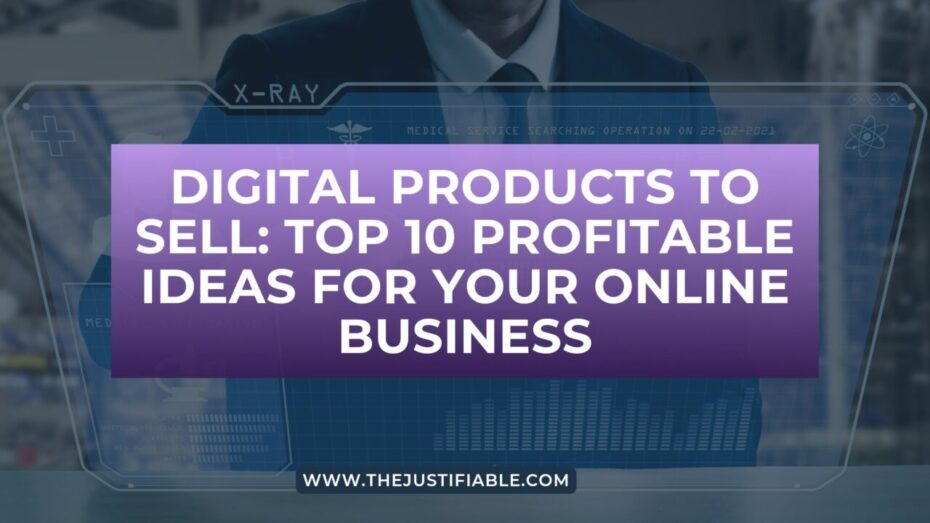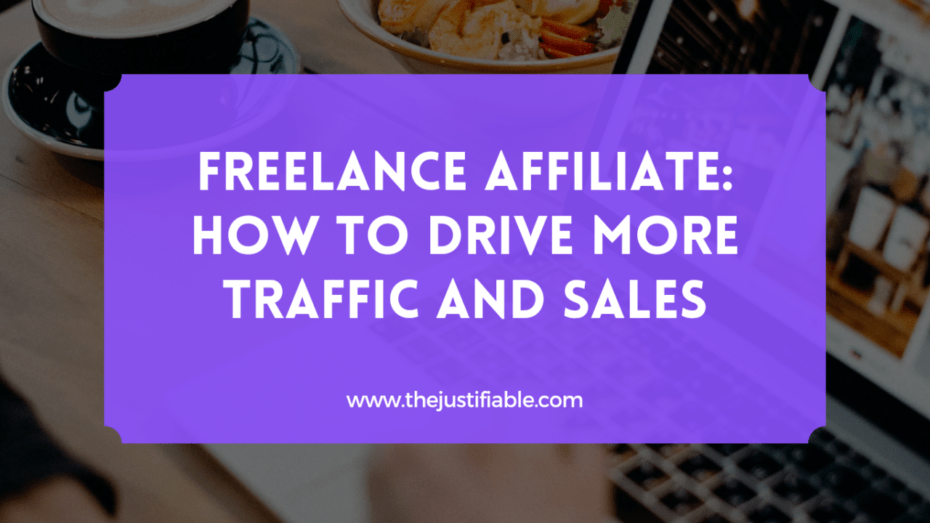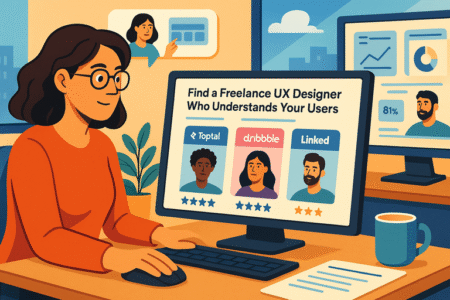Table of Contents
Being a freelance graphic designer is more than just making beautiful visuals—it’s about making sure the right people actually see your work and want to hire you.
Marketing yourself is the part many creatives struggle with, but once you understand how to position yourself and build visibility, your skills will speak louder than any cold pitch ever could.
Build A Strong Personal Brand That Stands Out
Your personal brand is the foundation of your marketing. It’s the story people associate with your work before you even introduce yourself.
Define Your Visual Identity And Voice
Think of yourself as your own client. Choose a consistent color palette, typography, and design style that reflects the kind of work you want to attract.
Your logo, portfolio, and even your Instagram posts should look like they come from the same designer.
When it comes to your voice, be intentional. Are you the minimalist who believes “less is more”? Or the bold experimenter who thrives on vibrant, playful visuals?
Aligning your visuals with your tone makes your brand unforgettable.
Create A Compelling Portfolio Website
A portfolio isn’t just a gallery—it’s your best sales tool. Highlight no more than 8–12 projects that represent your ideal work.
For each project, include a short case study: What the client needed, how you approached it, and the impact of your design. A quick before-and-after visual comparison can instantly communicate value.
Make sure your site has a clear call to action: “Let’s Work Together” or “Hire Me” should be visible without scrolling.
I suggest using a tool like Webflow, Squarespace, or WordPress with a clean template—you don’t need something flashy, just functional and professional.
Pro Tip: Add a short “About Me” video. People connect faster with a face and voice than a paragraph of text.
Use Social Media As A Visual Showroom
Social platforms are powerful for designers because your work is the content. Done right, they act as free advertising for your skills.
Choose Platforms Strategically
Not every platform works the same. Instagram and Behance are perfect for showcasing visuals, while LinkedIn is better for connecting with business owners who actually hire designers.
Pinterest can drive long-term traffic to your portfolio, and TikTok works if you’re open to showing behind-the-scenes processes.
Share More Than Just Final Designs
Clients don’t just want to see polished end results. Share sketches, mood boards, and quick time-lapse videos of your process.
A post that shows “logo concepts that didn’t make the cut” often gets more engagement than the final logo. This builds trust and shows how much thought goes into your work.
Use Content Buckets
Rotate between:
- Portfolio Highlights (finished projects)
- Behind-the-Scenes (your process, workspace, tools)
- Educational Content (tips on branding, typography, color theory)
- Personal Insights (stories about challenges, lessons learned)
This way, your feed stays interesting without feeling repetitive.
Master Networking Without Feeling Salesy
The best projects often come from people who already know and trust you. Networking doesn’t have to feel like selling—it’s about building real relationships.
Join Design Communities
Slack groups, Discord servers, and online forums like Designer Hangout or Indie Hackers are full of potential collaborators and clients.
Contribute value before asking for anything—answer questions, share resources, and give feedback on others’ work.
Attend Local Events And Workshops
Even if most of your clients are online, showing up in person has impact. Business owners are more likely to hire the designer they had a real conversation with over coffee.
Bring a few business cards, but focus on genuine connection.
Follow Up Thoughtfully
When you meet someone, don’t just connect once and disappear. Send a short email or message: “I enjoyed chatting about your new brand idea.
If you ever need visuals, I’d love to help.” No pressure, just a reminder you exist.
Optimize Your Freelance Graphic Designer Portfolio For Search
SEO may sound intimidating, but it’s one of the most reliable ways to get clients consistently without relying on algorithms.
Use Keywords Naturally
Sprinkle phrases like “freelance graphic designer in [your city]” or “logo design services” into your site. Place them in headlines, project descriptions, and your About page without forcing them.
Blog To Show Expertise
Short tutorials, design breakdowns, or “How I redesigned this brand identity” posts can pull in clients searching for help. Keep articles client-friendly—write in plain English, not design jargon.
Make Your Work Shareable
Each portfolio page should have a direct link that’s easy to copy and share. When your work gets passed around in Slack channels or WhatsApp groups, that’s free marketing.
Collect Testimonials And Social Proof
People trust people. A glowing testimonial from a past client can do more to convince a prospect than your portfolio alone.
Ask At The Right Time
The best time to ask for a testimonial is right after a client says something positive, like “This design is perfect.” Strike while the enthusiasm is fresh.
Display Testimonials Creatively
Instead of a plain quote, pair it with the client’s logo or a short video clip. Even better—include a mini case study: “After working with me, their Instagram engagement went up 45%.” Hard numbers make your work feel tangible.
Offer Value Before Selling Services
One of the most effective ways to attract clients is to help them before they even hire you.
Create Free Resources
This could be a PDF guide like “5 Mistakes Small Businesses Make With Their Logos” or a free downloadable social media template pack.
Offer it in exchange for an email address, and you’re building a client list.
Share Mini Audits
Pick a few brands you admire (or see struggling) and do a quick visual redesign mockup.
Share it on LinkedIn or Instagram: “Here’s how I’d improve this restaurant’s branding.” You’re not just showing skill, you’re giving potential clients ideas.
Set Pricing And Communicate Value Clearly
Marketing is only half the battle. You need to make it easy for clients to say yes once they’re interested.
Show Packages Instead Of Hourly Rates
Instead of “$50/hour,” present packages like:
- Logo Design Package: $500
- Brand Identity Package: $1,200
- Social Media Kit: $800
Packages communicate outcomes instead of time, which feels more valuable to clients.
Explain Your Process
Walk clients through your steps: discovery, sketches, revisions, delivery. When they understand the work involved, your price feels justified.
Keep Improving Through Feedback And Experimentation
Marketing yourself as a freelance graphic designer isn’t a one-time setup—it’s ongoing.
Track What Works
Check where your inquiries are coming from: Instagram, SEO, referrals? Double down on the channels that actually bring paying clients.
Ask For Constructive Feedback
Don’t just ask, “Do you like my portfolio?” Instead ask, “What would make this clearer for you?” or “What do you wish I showed more of?”
Experiment With New Formats
Try newsletters, YouTube tutorials, or even podcast guest spots. The more places people see you, the more likely they’ll remember you when they need a designer.
Expert Tip To Take Away
Clients don’t just buy design—they buy trust, reliability, and clarity. The way you market yourself should always communicate those three things.
When your branding, online presence, and communication align, your work sells itself.






